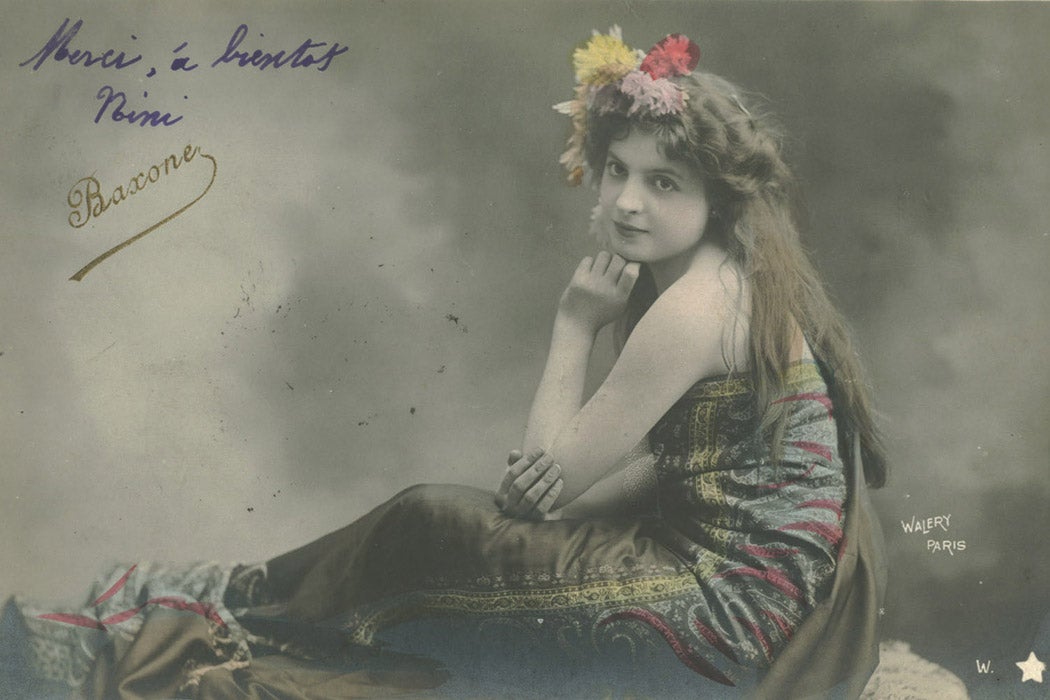Postcards were legitimized as a form of international mail in 1886 by the Congress of the Universal Postal Union. “They were cheap, bright, multi-purpose, and pervasive,” writes historian Lisa Z. Sigel, so much so that between 1894 and 1919, “roughly 140 billion” postcards were mailed worldwide. It’s little wonder that pornography, which quickly finds its way to new forms of mass communication, became associated with postcards. Particularly French postcards.
“Postcards instituted racialist images of colonial subjects and foreign people,” writes Sigel. “They naturalized images of women as passive, sexual objects. They created an inherent, instinctual sexuality in children. In short, postcards reproduced pre-existing beliefs through which Victorian and Edwardian society ordered people.”
“French postcard” became a euphemism for the postcard-sized, card stock paper pornographic image. They were not necessarily mailed—censorship ruled that out if the postcards showed pubic hair, genitals, or nipples—unless in envelopes, but they could be purchased from legitimate venues or, more shadily, on the street. The notable exception for mailing: images of exotic, foreign, or colonial subjects. Staged views of “native” women’s sexuality was coded as natural and thus allowed by most European censors.
“The cards created foreignness and ideas of racialism and then documented them,” writes Sigel. “Domestic cards” portraying white European women, meanwhile, “reinforced current ideas about sexuality and women’s centrality to its configuration.”
Another type of postcard was the comic card, which “often subverted the social order by ridiculing both the privileged and the low in society.” These mixed “sexuality, scatology, and critique in ways that devalued the bourgeois seriousness of sexuality.” The English fox hunt, for instance, “allowed fertile ground for criticism and ribaldry.” The “defecation, urination, and flatulence [that] had been removed from the purified, hygienic, sexual body over the course of the nineteenth century” were brought back with comic cards.
Nonetheless, pornographic “postcards did not offer sexual liberation,” writes Sigel. They did, however, “revolutionize pornography.” As she details, pornography was transformed during the 1880s and 1890s from a largely elite written medium to a mass pictorial one. The resulting images, especially in cheap postcard format, expanded the audience for porn from the upper to the working classes. Anybody could buy such postcards or view them in penny viewing machines (the cards prefigured motion picture technology, which of course was quickly adopted by pornographers).
All this worried elites, Sigel explains, and “authorities insisted that the working classes need to conform to official standards of public morality.”
In the minds of officials, “women seeing nakedness could in itself be dangerous, even though women’s nakedness was central to aesthetic objectification.” This went for pornography and high art: as late as 1893, women were not admitted to the life drawing classes at the Royal Academy of Art in London.
“Women, children, the working classes, and people of color violated their ‘categories of being’ as object when they laid claim to the same prerogatives of aesthetic objectivization as had their social betters,” Sigel writes. “As people who had been viewed began to view sexual representations, pornography began to take on threatening connotations.”
Elites who made up the market for books that sexualized girls didn’t want girls to consume sexual culture. Similarly, white men could peruse images of both white women and women of color and read pornographic books about Black men with white wives, but colonial officials cracked down on pornographers who marketed images of white women to African men.
Weekly Newsletter
“You have committed a grave beach of the law,” declared the judge condemning a pornographer to a year and a half in jail and a £300 fine. “What makes it worse still is this: you sold and showed these most filthy pictures to the natives.”
“The social implications of ‘filth’ in the wrong people’s hands did more than expose hypocrisy,” writes Sigel, “it exposed sexuality as a method of social control.”







